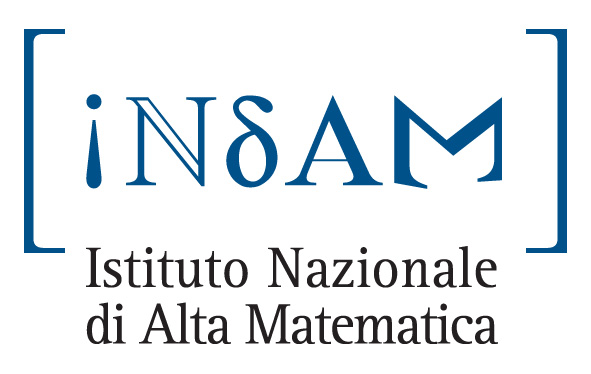
New connections between dynamical systems and Hamiltonian PDEs
NAPOLI, April 1- June 6, 2009

 |
Indam intensive period New connections between dynamical systems and Hamiltonian PDEs NAPOLI, April 1- June 6, 2009 |
 |
| Home | Speakers April-May | Speakers workshop | Timetable | Locations |
| Vieri Benci
(Università di Pisa): Solitary waves, solitons and vortices |
Roughly speaking a solitary wave is a solution of a field equation whose energy travels as a localized packet and which preserves this localization in time. The first part of this talk is an introduction to the study of solitary waves relative to the Shroedinger equation, to the Nonlinear Wave Equation and to the Gauge Theories (GT). GT's consist of a class of field equations obtained by coupling in a suitable way the nonlinear wave equation with the Maxwell equations (in the Abelian case) or the Yang-Mills equation (in the SU(2) case). A particular type of solitary waves which might occur in GT's are the vortices. A three dimensional vortex is a finite energy solution of these equations in which the magnetic field looks like the field created by a finite solenoid.
In the last part of the talk, we will present some new results realative to the dynamics of solitons when an external potential is present.
| F. Calogero
(Dipartimento di Fisica, Università di Roma "La Sapienza"
and Istituto Nazionale di Fisica Nucleare, Sezione di Roma): Isochronous dynamical systems and the arrow of time |
A vector-valued time-dependent function is called isochronous if all its components are periodic in time with the same fixed period T. A dynamical system is called isochronous if its generic solution is isochronous: periodic in all its degrees of freedom with a fixed period T independent of the initial data. It will be shown how essentially any (autonomous) dynamical system can be extended or modified into another (also autonomous) dynamical systems which is isochronous with an (arbitrarily !) assigned period T, and which moreover behaves, over time periods very short with respect to T, essentially as the original (unmodified) system---up to a constant time rescaling. This can also be done for a large class of Hamiltonian systems (both the unmodified and the modified one), including the Hamiltonian describing the most general (classical, nonrelativistic) many-body problem (provided it is, overall, translation-invariant). Some implications of this fact for statistical mechanics and thermodynamics will be mentioned, and for the distinction among integrable and nonintegrable dynamical systems (all isochronous systems are integrable, in fact maximally superintegrable). It will also be shown how the most general Hamiltonian system can be embedded inside a superintegrable Hamiltonian system.
These findings have all been obtained together with F. Leyvraz: some of them are reported in my monograph entitled Isochronous systems (Oxford University Press, 2008), others are more recent.
| Jiansheng Geng: Quasi-periodic solutions for two dimensional cubic Schrodinger equation without the outer parameter |
In this talk, we give an infinite dimensional KAM theorem. Applying it to the two dimensional nonlinear Schröedinger equation iut-Δ u +|u|2u=0, t ∈ R, x ∈ T2 with periodic boundary conditions, we prove that the above equation admits a Whitney smooth family of small-amplitude quasi-periodic solutions corresponding to finite dimensional invariant tori for an associated infinite dimensional dynamical system. This is a joint work with X.Xu and J.You.
| Benoit Grébert
(Université de Nantes): Normal forms and geometric numerical integration of semi linear Hamiltonian PDEs |
We consider a class Hamiltonian PDEs that can be split into a linear unbounded operator and a regular non linear part. The goal of this work is twofold: First we show how standard numerical approximation methods cannot avoid resonances issues except if the linear part is truncated in the high frequencies. We then give a sharp bounds for the cut-off depending on the time step. Using a normal form result, we show the long time preservation of the actions for such schemes for all values of the time step.
| S. Volberg (Michigan
State University): Jacobi matrices generated by polynomial dynamics, Toda lattice, and estimates of Hilbert transform |
This talk is based on a joint work with P. Yuditskii and Franz Peherstorfer, in it we are going to show a Lipschitz property of Jacobi matrices built by orthogonalizing polynomials with respect to measures in the orbit of classical Perron-Frobenius-Ruelle operator associated to hyperbolic polynomial dynamics. This Lipschitz estimate will not depend on the dimension of the Jacobi matrix. In the second part of the talk for all polynomials with sufficiently big hyperbolicity we can prove that Lipschitz estimate becomes exponentially better when dimension of Jacobi matrix grows. This allows us to get for such polynomials the solution of a problem of Bellissard, in other words, to prove the limit periodicity of the limit Jacobi matrix. We suggest the scheme how to approach Bellissard's problem for all hyperbolic dynamics by uniting the methods of the first and the second part. On the other hand, the nearness of Jacobi matrices under consideration in operator norm implies a certain nearness of their canonical spectral measures. One can notice that this last claim just gives us the classical commutative Perron-Frobenius-Ruelle theorem (it is concerned exactly with the nearness of such measures). In particular, in many situations we can see that the classical Perron-Frobenius-Ruelle theorem is a corollary of a certain non-commutative observation concerning the quantitative nearness of pertinent Jacobi matrices in operator norm.
| Xiaoping Yuan (School of
Mathematical Sciences, Fudan University): KAM tori of linear Schröodinger equations with different perturbations |
In this talk, we are concerned with the existence of KAM tori for the linear Schrödinger equations with different perturbations, such as non-Hamiltonian perturbation and unbounded perturbation.